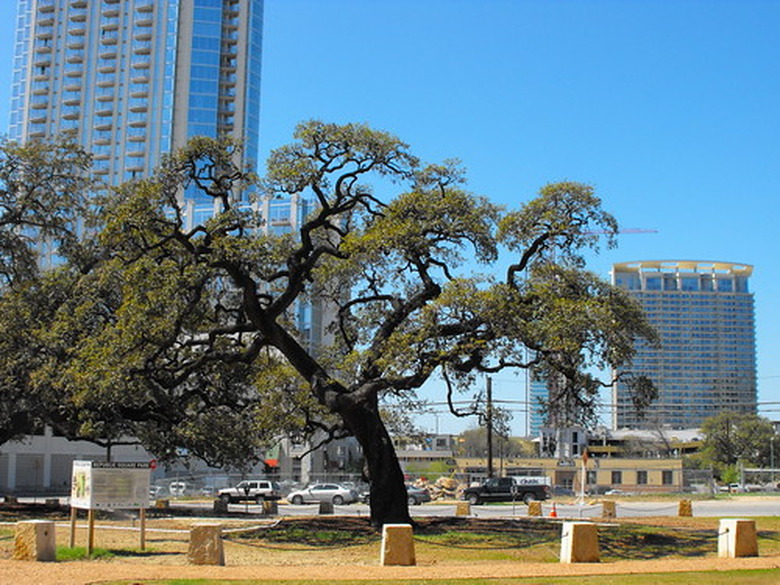Live Oak Tree Identification
The live oak can grow into a majestic tree, a quality that helped make it Georgia's state tree. Live oak grows along the coastal plain of the southeastern United States, from Maryland to Texas. The tree takes its name from the fact that unlike most oak trees that lose their leaves come winter, the live oak is an evergreen species. Not only does live oak live for a long time, it has some of the hardest wood; the timbers of "Old Ironsides," the ship named the U.S.S. Constitution, are made from this tree. The tree has specific identifying characteristics.
Size
The live oak is a wide tree at the top, spreading out to cover a large area with its branches. This is one of the tree's most recognizable features. The tree can be from 65 to 85 feet tall, and some will have a spread of 150 feet across at the crown. The trunks of live oaks typically possess diameters of 3 to 4 feet and are relatively short compared to the overall size of the tree.
- The live oak can grow into a majestic tree, a quality that helped make it Georgia's state tree.
- The tree takes its name from the fact that unlike most oak trees that lose their leaves come winter, the live oak is an evergreen species.
Leaves
Botanists classify live oak leaves as simple leaves, meaning they are one single solid leaf on a stem. These leaves are narrow and have an elliptical shape, between 2 and 5 inches in length and about 2 inches wide. The upper portion of the leaf is shiny with a darkened green hue, while the bottom is duller and has a gray-green shade. Live oak leaves have a leathery texture and can stay on the tree through the winter months before replacement leaves grow in the spring.
Acorns
The acorns a live oak produces seldom exceed one inch in length. They have a broad base and taper to a pointed tip. Light brown in color in the cap, at the point where the acorn attaches to the oak tree, the majority of the fruit is a darker brown, with some looking nearly black. These acorns grow by themselves on the tree or in clusters of as many as five nuts. Unlike many types of acorns, the meat of the live oak acorn is not bitter tasting.
- Botanists classify live oak leaves as simple leaves, meaning they are one single solid leaf on a stem.
- Light brown in color in the cap, at the point where the acorn attaches to the oak tree, the majority of the fruit is a darker brown, with some looking nearly black.
Bark
The bark of a live oak is dark brown, with some developing a dark red-brown look to them. It has many furrows in it, but these are not deep, ingrained in the upper layers of the bark. Ridges also permeate the bark, which can appear scaly or blocky as the live oak tree matures. The older live oaks have an almost black bark.
Habitat
Someone may use the habitat of the live oak to aid in its identification. The tree often grows in stands of several live oaks, but it may also exist as an individual tree within a woodlot of other types of trees, such as the laurel oak and the water oak as well as American holly and the southern magnolia.
References
- University of Florida: Live Oak
- "Field Guide to Trees of North America;" C. Frank Brockman; 1986
